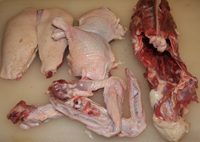| ABOUT
DUCK FAT
See
Also:
How to Render Duck Fat
Duck
confit is one of my favorite dishes to cook
for guests. It can be made several days ahead
and stays well in the refrigerator immersed
in duck fat for weeks. The only difficult part
in preparing the dish is accumulating all the
duck fat that is needed to completely cover
the legs during cooking. If one purchases duck
fat the cost of the dish rises sharply. . For
that reason I tend to buy a whole duck, render
my own duck fat and then use the carcass for
duck stock. A whole duck can render approximately
12 oz. of fat. And, of course you will be left
to two duck breasts for another meal.
Duck
is actually a great value in cooking when one
considers what a whole duck costs and what the
end results are.
Furthermore,
what many are unaware of is the health benefits
to duck fat. Duck fat contains 35.7% saturates,
50.5% monounsaturates (high in linoleic acid)
and 13.7% polyunsaturated fats.(Which contains
Omega-6 and Omega-3 essential oils). This compares
to olive oil which is: 75% monounsaturated fat
(mostly oleic acid) 13% saturated fat and 10%
Omega-6 linoleic acid and 2% Omega-3 linoleic
acid. The main difference between chicken, turkey
and duck is that duck contains more linoleic
acid, which chicken and turkey contain a higher
amount of polyunsaturated fats. It appears that
duck and goose fat is more like olive oil than
it is like butter or beef.
Additional
Facts about Duck Meat --Source: Fatty Acids
in Foods and Their Health Implications"
Ching Kuang Chow
"Duck
and goose muscle are predominantly dark muscle
throughout the carcass. Duck muscle contains
5.95% lipid without the skin and 39.34% with
skin. Muscle alone contains 50.3% saturated,
33.4% monounsaturated and 16.3% polyunsaturated
fatty acids, whereas duck with skin contains
35.7% saturates; 50.5% monounsaturates and 13.7%
polyunsaturates As with chicken and turkey the
addition of the skin increases the proportion
of monounsaturated fatty acids in the lipid
from duck. The major fatty acids in duck fat
are similar to those in chicken and turkey except
for the absence of long chain PUFA's and a higher
proportion of linoleic acid. " Source:
"Fatty Acids in Foods and Their Health
Implications" Ching Kuang Chow
| |
|
|
 |
|
Starting with a whole duck
saves money. |
| |
|
|
 |
|
Cut up the duck....
You can use breasts for excellent crispy
duck breasts (See recipes below)... legs
for confit or rillettes... and carcass
and wings for stock.
|
| |
|
|
 |
|
Cleaning off the
carcass and rendering the duck fat will
yield approximately 12 oz. See -- How
to Make Duck Fat |
The French Paradox
In
the United States, 315 of every 100,000 middle-aged
men die of heart attacks each year. In France
the rate is 145 per 100,000. However, In the
Gascony region, where goose and duck liver form
a staple of the diet, this rate is only 80 per
100,000 (See below: Can Foie Gras aid the heart?)
This phenomenon has recently gained international
attention as the French Paradox --They eat more
fat in Gascony than anyplace else, but they
live the longest .
STORING
DUCK FAT
It
is important in storing duck fat that there
are no water soluble products in the fat. This
can increase the level of oxidation and decrease
the lifetime of the fat. After leaving the fat
to rest in the refrigerator for a day or two
remove and scrape off the liquid at the bottom
which will be an excellent source of rich duck
stock for your sauce (See image below).
Also
skim any nonfat substances that may have risen
to the top of the fat. What's left will stay
fresh in the refrigerator for a long period
of time and can be used again for confit or
frying vegetables -- it is an excellent alternative
to butter.
Articles
How
to Render Duck Fat
The
Truth about Saturated Fats
The
Duck Stops Here
Can
Foie Gras Aid the Heart? A French Scientist
Says Yes
The
French Paradox
Characterizing
Quality of Rendered Duck Fat
|

